3D palaeogeographic reconstructions of the Phanerozoic versus sea-level and Sr-ratio variations: Discussion
G. Shanmugam*
Department of Earth and Environmental Sciences, The University of Texas at Arlington,Arlington, TX 76019, USA
KEYWORDS submarine fans,mass-transport deposits,submarine canyons,sea-level changes,glacial isostasy,Sr-ratio curve,tectonics,paleobathymetry
Abstract Vérard et al. (2015, Journal of Palaeogeography, 4(1): 64-84) claim that their global geodynamic model allows one to reconstruct the surface features of topography on land and in adjacent oceans (i.e., paleobathymetry) anywhere on the globe and at any geological time during the past 600 million years (Ma). Such a grand model requires a rigorous scrutiny. The purpose of this discussion is to illustrate that the model suffers from (1) the selective omission of real-world datasets that do not fit the model, (2) the inclusion of datasets without revealing their original sources or without citing relevant peer-reviewed publications, (3) the emphasis on ‘unpublished’ internal company datasets that disallow open access to the international scientific community, and (4) the use of poorly understood concepts without providing the basic conceptual clarity. These deficiencies undermine the credibility of the heuristic model.
1 Introduction
The incentive for this discussion came from an editorial by Feng (2015), which appeared in the January issue of 2015 of the Journal of Palaeogeography entitled “Hope to be from model to practice — Words of the Editor-in-Chief”,on an article “3D palaeogeographic reconstructions of the Phanerozoic versus sea-level and Sr-ratio variations” by Vérard et al.(2015). Vérard et al.(2015, p. 64) claim that “A full global geodynamical model over 600 million years (Ma)has been developed at the University of Lausanne during the past 20 years. We show herein how the 2D maps were converted into 3D (i.e., full hypsometry and bathymetry),using a heuristic — based approach. Although the synthet?ic topography may be viewed as relatively crude, it has the advantage of being applicable anywhere on the globe and at any geological time.” As a process sedimentologist and as a petroleum geologist who has spent the past 40 years in understanding the importance of deep-water sedimentation and their implications for petroleum reservoirs (Shanmugam, 2006, 2012, 2015), I was initially enthusiastic about the geodynamical model because of its unlimited potential for application in time and space. However, after a critical review of the paper, my enthusiasm for the model has waned. The methodology and datasets used in developing the model raise serious questions on several fundamental levels. The objective here is to identify specific problem areas associated with the model using the following topics:
·Submarine fans and other depositional systems
·Mass-transport deposits (MTD)·Submarine canyons
·Sea-level changes
·Glacial isostasy
·Sr-ratio curve
·Tectonics and paleobathymetry
2 Submarine fans and other depositional systems
Vérard et al.(2015, p. 72) state that “Sedimentation does not reflect local climatic variations, nor does it ac?count for local variations in detrital input. Lakes or rivers are not taken into account on continents, and deep sea fans are not modelled here. The amount of sediment in all major deep sea fans, however, is estimated to represent less than 0.01% (order of 1014to 1015m3) of the total sedi?ment volume in ocean.”
Although it is the authors’ prerogative to include or exclude certain datasets in their research, the total exclusion of sedimentation in rivers, lakes, and deep-sea fans from consideration is not only geologically unrealistic but deeply troubling. During the past four decades, various aspects of modern and ancient submarine fans have been well documented (Bouma et al., 1985; Curray et al., 2003, among others; Mutti and Ricci Lucchi, 1972; Shanmugam and Moiola, 1985, 1988; Shanmugam et al., 1985a, 1985b; Weimer and Link, 1991). From a topographic viewpoint, submarine fans constitute important sites of sediment accumulation in the world’s oceans (Fig. 1). Barnes and Normark (1985)have compiled dimensions of 21 modern fans and 10 ancient fans. Fans have impressive dimensions (Table 1). The world’s largest submarine fan, known as the Bengal Fan(Fig. 2), has a length of 3,000 km, a width of 1,430 km, and a sediment thickness of 16.5 km (Curray et al., 2003). Although the Bengal Fan virtually occupies the entire length of the Bay of Bengal (Fig. 2), it has been discarded from the model. This and other issues are identified below.
· Despite the authors’ claim that the geodynamic model is “applicable anywhere on the globe and at any geologi?cal time”, the model is not applicable everywhere. In fact,Vérard et al. (2015, p. 73) concede that the Bengal Fan is not represented in the synthetic topography created by the model.
· One of the problems with the paper by Vérard et al.(2015) is their failure to cite peer-reviewed publications in revealing the original datasets. For example, the first published estimate of sediment thickness for the Bengal Fan was >5 km (Curray and Moore, 1974; see also Barnes and Normark, 1985). This value was later updated to 16.5 km(Curray et al., 2003). But Vérard et al. (2015, p. 73) claim a new sediment thickness of “more than 20 km” for the Bengal Fan, without citing any peer-reviewed reference. If the authors have new seismic datasets of their own to validate the 20-km thickness of the Bengal Fan, they should publish the seismic profiles with their interpretations.
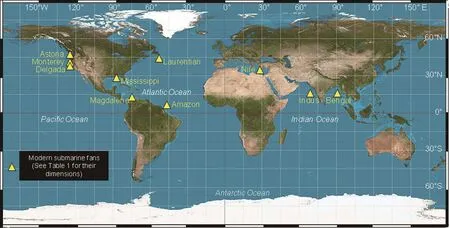
Figure 1 Map showing 10 large modern submarine fans in the world (Bouma et al., 1985). See Table 1 for dimensions of these fans.Blank world map credit: http://upload.wikimedia.org/wikipedia/commons/8/83/Equirectangular_projection_SW.jpg (accessed January 20, 2015).
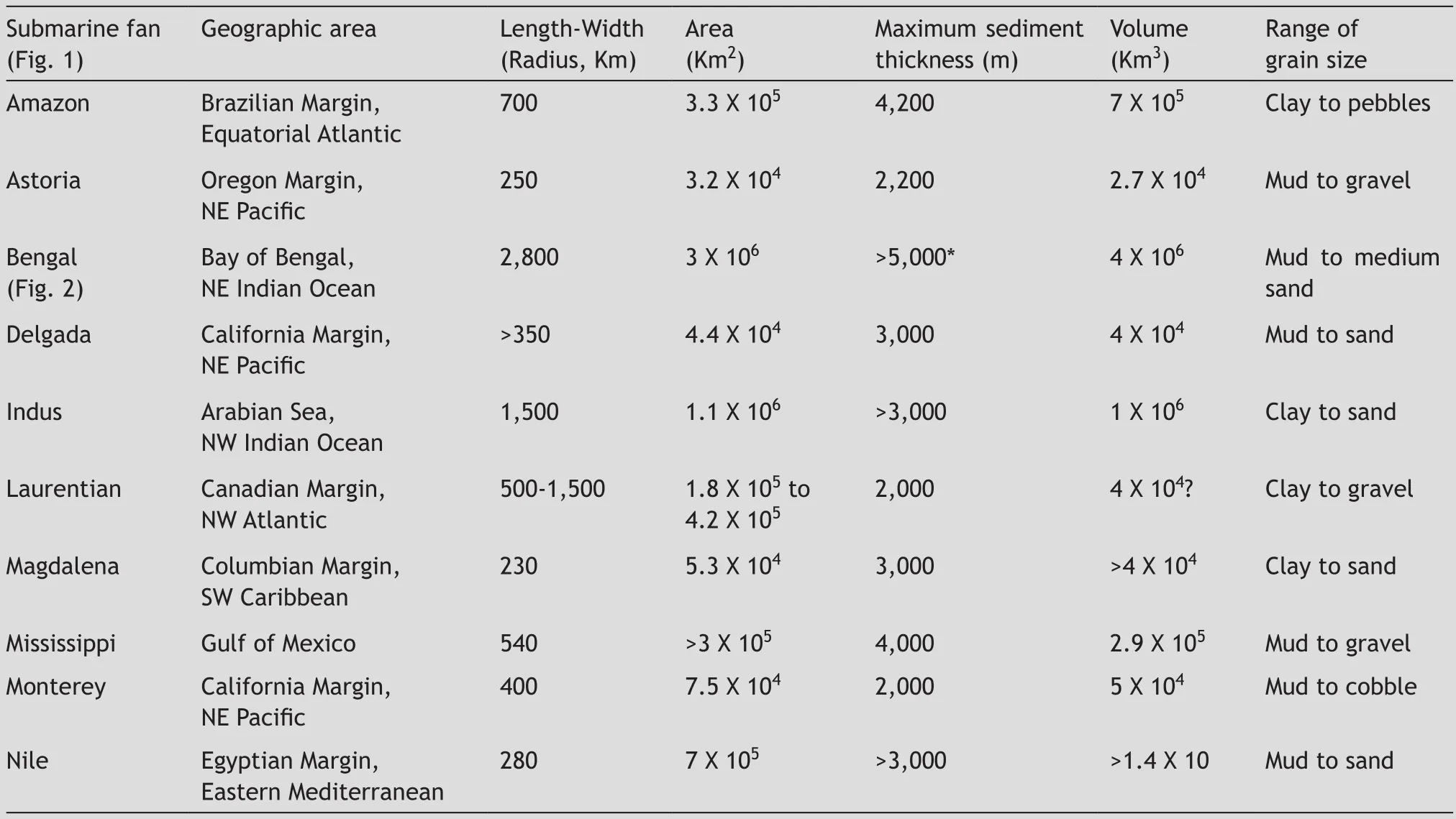
Table 1 Empirical data on dimensions of 10 large modern submarine fans in the world’s oceans. Note the world’s largest modern fan,known as the Bengal Fan (Fig. 2), with 16.5 km in sediment thickness. Compiled from a chart (see inside pocket of book’s back cover)by Barnes and Normark (1985)
· Vérard et al. (2015) present a simplistic notion that deep-sea fans represent the entire deep-sea depositional system. The reality is that deep-sea depositional systems are highly complex and that fans represent only one of many systems (Shanmugam, 2012). Each system is controlled by various deep-sea processes. For example, (1) gravity-driven downslope processes tend to form deposits of slides,slumps, debris flows, and turbidity currents (Dott, 1963);(2) contour-following thermohaline currents develop contourites along continental slopes and rises (Hollister, 1967);(3) deep-marine tidal currents deposit tidalites in submarine canyons (Shanmugam, 2003); and (4) internal-wave related baroclinic currents tend to accumulate baroclinites on continental slopes and on guyots (Shanmugam, 2013).These processes may or may not be part of a submarine fan. Did the authors consider this variability of sediments in estimating the total marine sediment volume?
·If fans represent less than 0.01% of the total marine sediment volume, is the remaining 99.99% of marine sediment composed of non-fans? What is the depositional origin, texture, and mineral composition of non-fans?
·In documenting that the total volume of sediment in all major deep-sea fans indeed accounts for less than 0.01%, Vérard et al. (2015) need to identify the original datasets (i.e., names, locations, sediment volumes, and related references) of individual fans used in their calculation.
·Each fan is a local accumulation of sediment (Fig.1). However, a total volume of 0.01% obtained by lumping together all fans worldwide is meaningless. Is there an“absolute threshold value” of sediment volume for all fans in order for “fans” to be considered as a distinct entity in the geodynamic model?
· Finally, Vérard et al. (2015) excluded sediment input by rivers and lakes on continents. Is it because river and lake deposits are volumetrically insignificant? Did Vérard et al. (2015) consider other depositional systems on Earth(e.g., Reading, 1996), such as alluvial fan, eolian, glacial,volcanic, deltaic, beach, estuarine, and shelf environments in building their model?
3 Mass-transport deposits (MTD)
Vérard et al. (2015) do not acknowledge the geologic importance of mass-transport deposits (MTD) in building their model. The general term “mass transport” represents the failure, dislodgement, and downslope movement of either sediment or glacier under the influence of gravity. Mass-transport deposits occur in both submarine and subaerial environments (Fig. 3). MTD are composed of slides, slumps, and debrites, but not turbidites (Dott,1963). MTD are important not only because of their volumetric significance in the sedimentary record (Gamboa et al., 2010), but also because of their potential for developing deep-water petroleum reservoirs (Shanmugam, 2012).MTD are an important component of certain large modern submarine fans, such as the Amazon Fan (Damuth et al.,1988; Piper et al., 1997). Importantly, MTD constitute significant local topographic features worldwide, and they vary in size greatly (Shanmugam, 2015). For example,Greene et al. (2006) described the large (130 km2) Goleta landslide complex located off Coal Oil Point near the town of Goleta, southern California (Fig. 4). It measures 14.6 km long extending from a depth of 90 m to nearly 574 m deep and is 10.5 km wide. Greene et al. (2006) have estimated that approximately 1.75 km3has been displaced by this slide during the Holocene. On the other hand, the world’s largest submarine MTD is the Agulhas Slump in SE Africa (Dingle, 1977), which is 20,331 km3in size. However, Vérard et al. (2015) have totally ignored the importance of both submarine and subaerial MTD in building their model.
·What is the reason for ignoring MTD?
4 Submarine canyons
Vérard et al. (2015) do not acknowledge the topographic significance of submarine canyons in building their model.A submarine canyon is a steep-sided valley that incises into the seafloor of the continental shelf, slope and rise. Some major submarine fans, such as the Bengal Fan (Fig. 2), are associated with submarine canyons (Table 2). MTD are an important depositional facies in submarine canyons (Shanmugam, 2012). Despite the fact that submarine canyons are the ubiquitous topographic features on the continental margins of the world (Carlson and Karl, 1988; Harris and Whiteway, 2011; Normark and Carlson, 2003; Shanmugam,2002; among others; Shepard and Dill, 1966), Vérard et al.(2015) have altogether ignored the importance of submarine canyons.
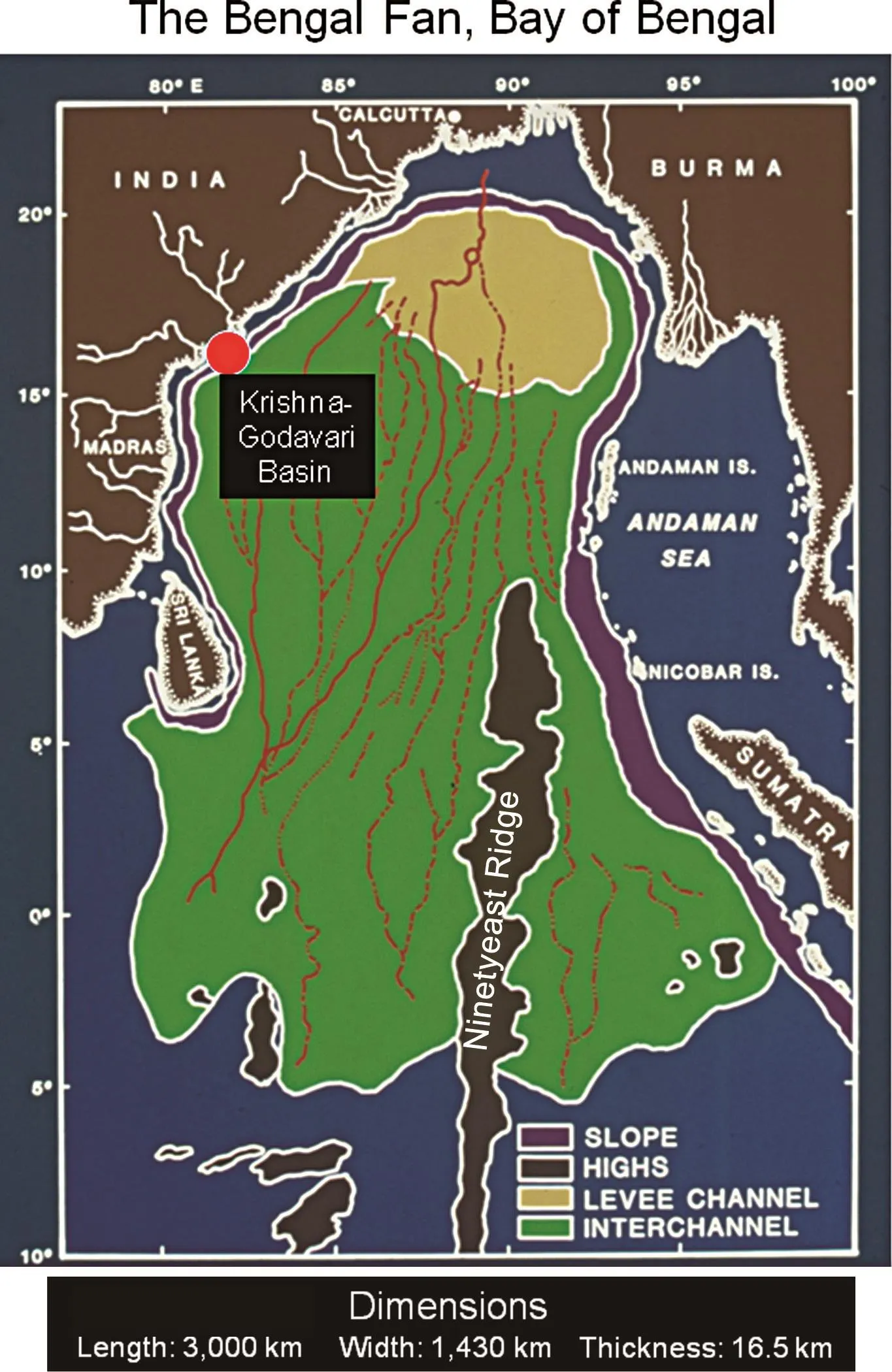
Figure 2 Map showing the distribution of the world’s largest fan in the Bay of Bengal, originally described by Curray and Moore(1974). See Table 1 for dimensions of this and other fans. Note that the offshore Krishna-Godavari (KG) Basin (red-filled circle)contains important petroleum-producing deep-water sandstone reservoirs on the east coast of India (Shanmugam et al., 2009). Map from Curray et al. (2003). With permission from Elsevier Copyright Clearance Center’s RightsLink: Licensee: G. Shanmugam. License Number: 3615361505200. License Date: April 24, 2015.
Submarine canyons constitute complex topographic features that have direct implications for predicting local bathymetry (Fig. 5). Normark and Carlson (2003) compared submarine canyons and their cross-sections near the shelf edge worldwide (Fig. 6). Three of the world’s largest submarine canyons, Zhemchug, Bering, and Navarin, occur in the Bering Sea (Table 2). The Zhemchug Canyon has the largest cross-section (Fig. 6), and it has a volume of 5,800 km3(Carlson and Karl, 1988). The Bering Canyon has the largest area (30,800 km2) of all 11 canyons studied (Fig. 6,Table 2). From an economic point of view, submarine canyons are of significance. In the Bay of Bengal, the offshore Krishna-Godavari (KG) Basin contains important petroleumproducing deep-water sandstone reservoirs in submarine canyons (Fig. 2). These petroleum reservoirs are interpreted as canyon-fill sandy debrites and tidalites (Shanmugam et al., 2009).
·The incision by the Zhemchug Canyon on the Beringian margin is so colossal that the canyon floor has reached a water depth of 2.6 km (Fig. 6). Ignoring such a gigantic erosion topography from the model, for the sake of convenience, defies logic or common sense.
5 Sea-level changes
Vérard et al. (2015, their Fig. 17) discuss various models of sea-level changes for the Phanerozoic. The key sea-level curve used in their Figure 17 is attributed to a reference cited as “EXXON Petroleum Company, 1988”. But in the References section, this item is listed as “EXXON Petroleum Company, 1988. The EXXON ‘global’ sea-level curve; unpublished.”
·The use of proprietary (unpublished) datasets, owned by EXXON (a private oil company), in their paper is troubling. This is because the international scientific community does not have access to this dataset.
· Vérard et al. (2015) aptly emphasize the first-order cycles of sea-level changes controlled by tectonic activity.Although first-order cycles are important (Shanmugam and Moiola, 1982; Vail et al., 1977; Vail et al., 1991), fourth-and fifth-order cycles of sea-level changes are more important in dealing with local development of parasequences (Van Wagoner et al., 1988, 1990). However, Vérard et al. (2015)do not discuss higher-order cycles that have implications for sedimentation associated with tropical cyclones and tsunamis in shelf, slope, and basinal environments (Shanmugam, 2007, 2008). What is the reason for ignoring higherorder cycles?
6 Glacial isostasy
Vérard et al. (2015, p. 73) state that “Note, finally,that effects related to post-glacial isostatic rebounds or to dynamic topography are not accounted for in themodel.” The authors’ decision to ignore datasets on postglacial isostatic rebounds is puzzling. In a recent study,Rovere et al. (2014) combined field observations and glacial isostatic adjustment modeling to estimate the dynamic topography signal in three areas that are important to paleo-sea level studies of the Mid-Pliocene warm period (South Africa, West Australia and southeastern United States) and demonstrated that dynamic topography played a significant role in the post-depositional displacement of Pliocene, and even younger Pleistocene, shorelines. This study has provided a robust paleo-sea level elevation data set, corrected for glacial isostatic adjustment, that can be used to evaluate predictions from mantle flow models of dynamic topography. Previously, Peltier (1998, 2004)and Sella et al. (2007), among others, have discussed this issue.
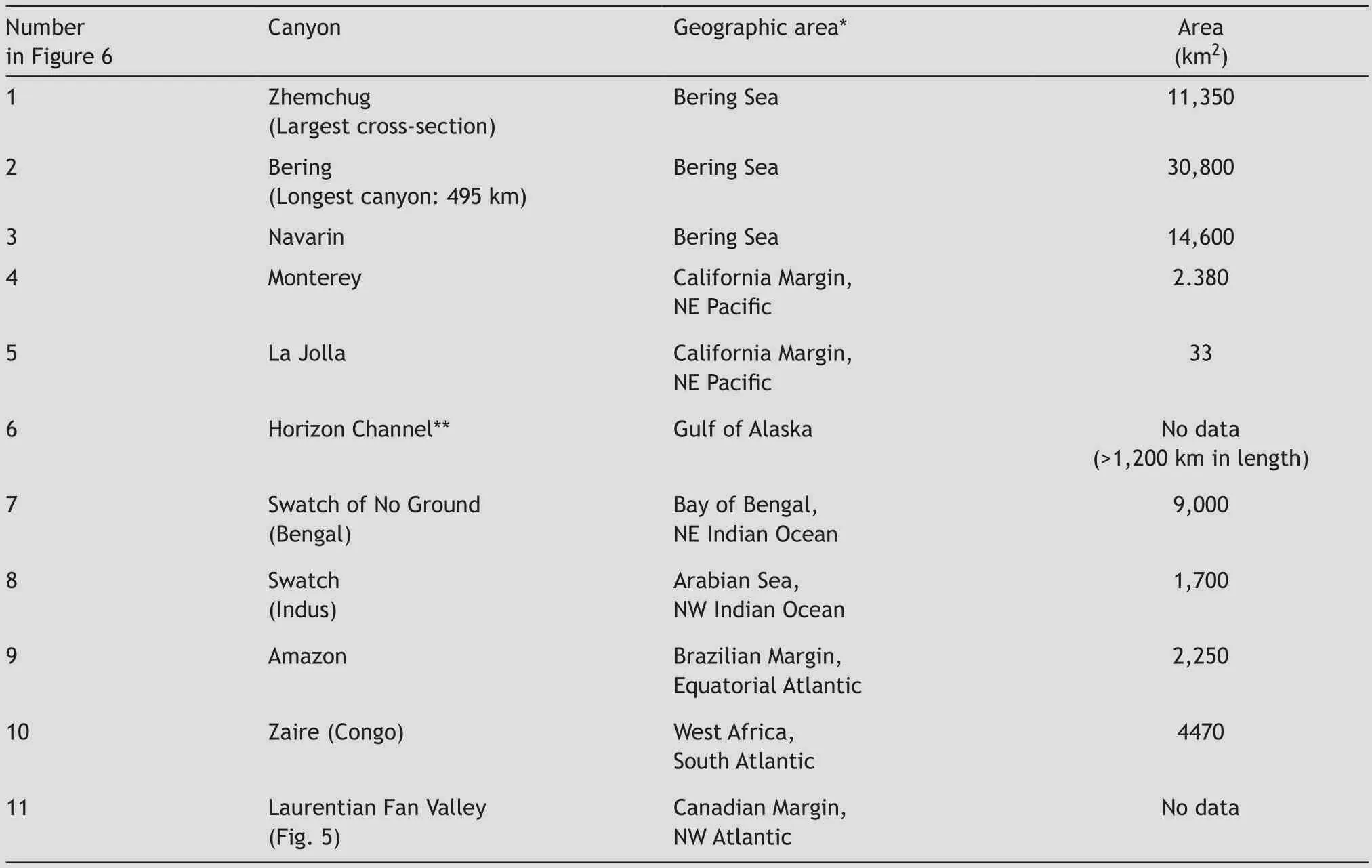
Table 2 Area of submarine canyons. Data compiled from Normark and Carlson (2003).

Figure 3 Map showing 50 examples of submarine (black triangle) and subaerial (white triangle) mass-transport deposits (MTD) that constitute significant local topography worldwide. MTD are often erroneously called “l(fā)andslides”. See Figure 4 for details of the Goleta slide.See Shanmugam (2015) for references for each MTD example and for details on core and outcrop description. With permission from the Journal of Palaeogeography.
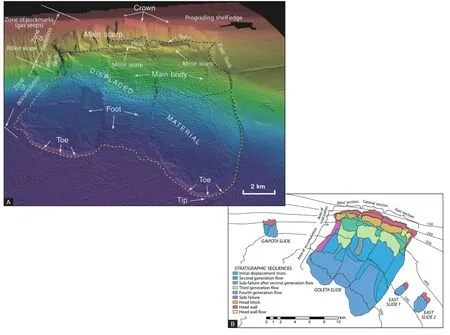
Figure 4 A-Multibeam bathymetric image of the Goleta slide complex in the Santa Barbara Channel, southern California. Note lobe-like(dashed line) distribution of displaced material that was apparently detached from the main scarp near the shelf edge. This mass transport complex is composed of multiple segments of failed material; B-Sketch of the Goleta mass transport complex in the Santa Barbara Channel, Southern California showing three distinct segments (i.e., west, central, and east). Contour intervals (-100, -200, -300, -400, -500,and -600) are in meters. From Greene et al. (2006). Images courtesy of H.G. Greene. Credit: European Geosciences Union.
· Vérard et al. (2015, p. 73) acknowledge that their model has failed in areas affected by post-glacial rebounds,such as Iceland, South Africa, North America, and Greenland. Clearly, the authors discard datasets that do not fit the model.
7 Sr-ratio curve
Vérard et al. (2015, p. 64) state that “The processes responsible for the long-term trend of the Sr-ratio curve,however, remain unclear, although Sr variations are com?monly associated with global tectonic activity (e.g., Veizer et al., 1999; McArthur et al., 2001).” It is worth revisiting the early history behind the Sr-ratio curve. Veizer (1989, p.154) summarized the pioneering history as follows: “In the 1970s the increased sampling density, the improvements in stratigraphic resolution, and particularly the development of a new generation of mass spectrometers stimulated vig?orous research effort, which culminated in the publication of the Mobil curve (Burke et al., 1982). The latter is pres?ently an unchallenged reference for the87Sr/86Sr ratio of Phanerozoic seawater, despite the fact that its analytical documentation has been published only for the Cretaceous and the Cenozoic (Koepnick et al., 1985).” I am familiar with the history of the “Mobil curve” because the original authors of the Sr curve (W. H. Burke, R. B. Koepnick, R.E. Denison, et aI.) and I were co-researchers in the same Geology-Geochemistry Research Group at the Mobil Field Research Laboratory in Dallas, Texas (USA) in the 1970s under the management of Dr. E. L. Jones. Although I did not work on the Sr-ratio project, I did work on aspects of eustasy and tectonics (Shanmugam et al., 1985b).
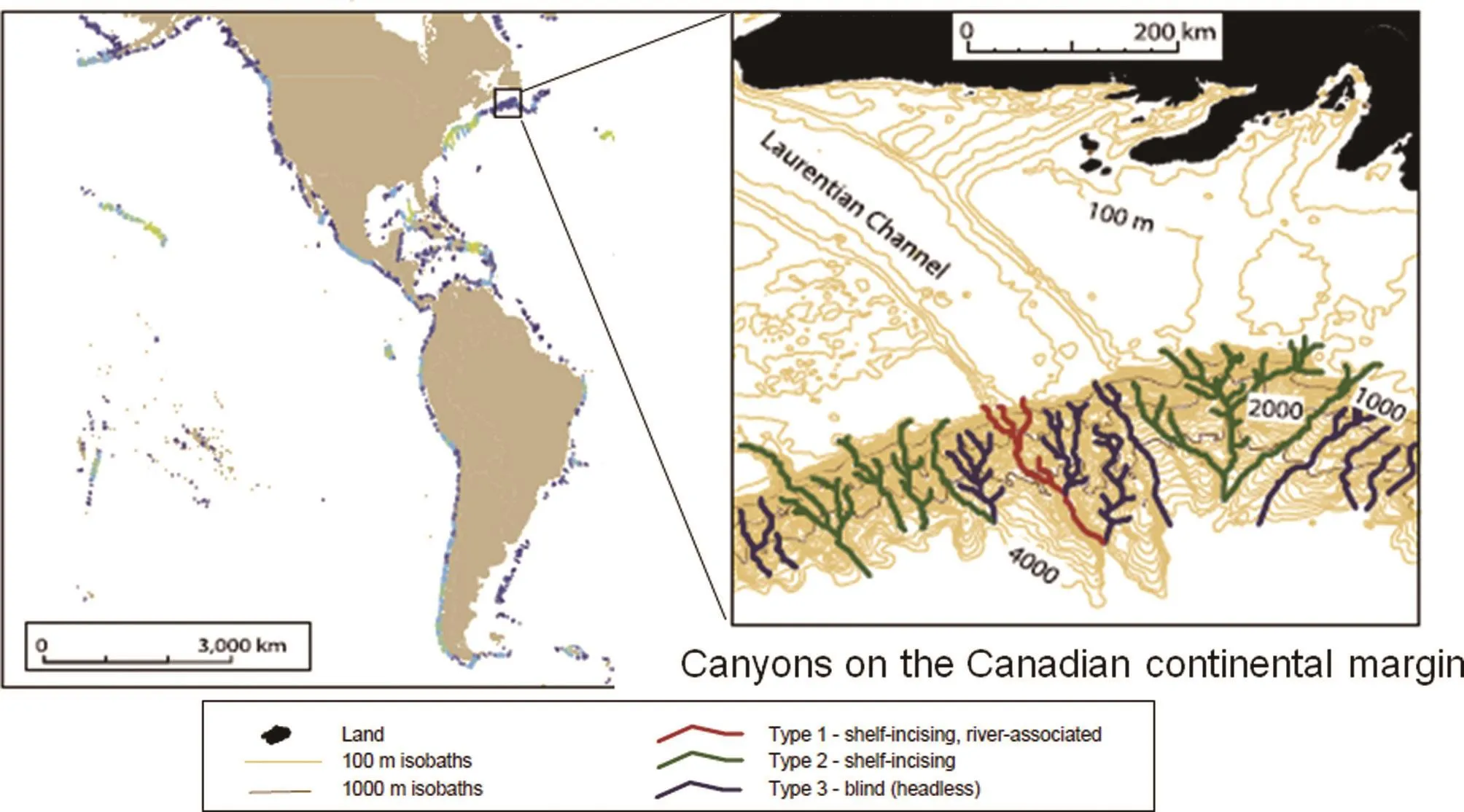
Figure 5 Map showing the distribution of Types 2 and 3 submarine canyons near the Laurentian Channel on the Canadian margin of the North Atlantic. Diagram compiled from Figures 5 and 6 in Harris and Whiteway (2011), with permission from Elsevier. Copyright Clearance Center’s RightsLink: Licensee: G. Shanmugam. License Number: 3615371044063. License Date: License Date: April 24, 2015.
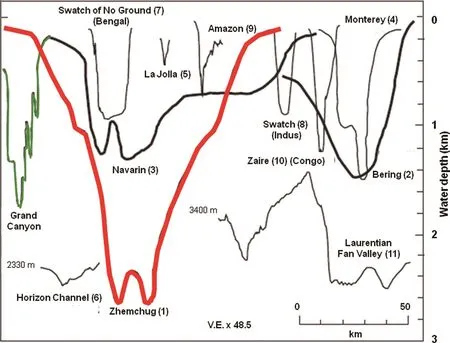
Figure 6 Comparison of cross-sections of 11 submarine canyons near the shelf edge worldwide. Note the world’s largest cross-section of the Zhemchug Canyon (red line). See Table 2 for area of all canyons. The subaerial Grand Canyon (green line) is shown for comparison. See Figure 5 for location of the Laurentian Channel. See Shanmugam (2012, his Fig. A-42) for geographic locations of these canyons. Figure after Normark and Carlson (2003), with permission from the Geological Society of America. See also Carlson and Karl (1988) for related details.
·Because the processes responsible for the long-term trend of the Sr-ratio curve remain unclear, it would be helpful if the authors could address this issue and provide the much-needed clarity.
8 Tectonics and paleobathymetry
One of the claims made by Vérard et al. (2015) is that the geodynamic model can establish paleobathymetry anywhere on the globe and at any geological time. However, reconstructing paleobathymetry of early Paleozoic sequences is a daunting task. These aspects have been addressed in a thematic edited volume entitled “Appalachian Geodynamic Research” (Walker and Roeder, 1978). Benedict and Walker(1978) proposed a multi-prong approach using (1) chemical, (2) sedimentologic, (3) biologic, and (4) stratigraphic indicators of paleobathymetry in Paleozoic sequences. This task becomes even more challenging when dealing with the highly complex tectonic evolution of a foredeep basin in the Ordovician of the central and southern Appalachians(Shanmugam and Lash, 1982).
In a tectono-stratigraphic study of the Middle Ordovician Sevier Basin in the Southern Appalachians, Shanmugam and Walker (1980) established a sudden increase in water depth of nearly 700 m based on local variations in physical, chemical, biological, and stratigraphic elements (Shanmugam and Walker, 1978). In particular, the manganese distribution in the carbonate fraction has revealed a diagnostic increase from shelf to basinal sequence (Shanmugm and Benedict, 1983). This bathymetric reversal from shelf to basinal sequences was attributed to “block” faulting in the Middle Ordovician (Shanmugam and Walker, 1980).
·The lesson here is that local bathymetric changes cannot be reconstructed using a global geodynamic model without input from local details on lithofacies, depositional facies, biofacies, tectonics, etc.
9 The bottom line
The proposed global geodynamic model, without inputs from the real-world datasets on local to regional sedimentation, erosion, and glacial isostasy, is inherently flawed.Therefore, the universal applicability of the model is dubious.
Acknowledgements
I thank Prof. Zeng-Zhao Feng (Editor-in-Chief of Jour?nal of Palaeogeography; China University of Petroleum,Beijing) for inviting me to contribute this discussion. I am grateful to Ms. Yuan Wang (Associate Editor-in-Chief, Editorial Office of the Journal of Palaeogeography, Beijing) for her editorial help. I wish to thank Prof. Zhong-Qiang Chen(Associate Editor-in-Chief of Journal of Palaeogeography;State Key Laboratory of Biogeology and Environmental Geology, China University of Geosciences, Wuhan) and Prof.Zhong Li (Institute of Geology and Geophysics, Chinese Academy of Sciences, Beijing) for their helpful reviews. As always, I am grateful to my wife, Jean Shanmugam, for her general comments. History behind this discussion:
· January 1, 2015: Vérard et al. (2015) and Feng (2015)published their article and editorial, respectively.
· January 2, 2015: In an e-mail to Prof. Feng on his timely editorial, I expressed my concerns over the challenges in reconstructing paleobathymetry of Paleozoic sequences based on my Ph.D. research (Shanmugam, 1978).
· January 7, 2015: In his e-mail response, Prof. Feng invited me to write an academic discussion on the paper by Vérard et al.(2015) explaining my views on issues associated with the model.
· January 21, 2015: I submitted this discussion.
 Journal of Palaeogeography2015年3期
Journal of Palaeogeography2015年3期
- Journal of Palaeogeography的其它文章
- Sequence architecture of a Jurassic ramp succession from Gebel Maghara (North Sinai, Egypt): Implications for eustasy
- Characteristics of the Paleozoic slope break system and its control on stratigraphic-lithologic traps: An example from the Tarim Basin, western China
- Lithofacies architecture and palaeogeography of the Late Paleozoic glaciomarine Talchir Formation, Raniganj Basin, India
- Palaeogeography of a shallow carbonate platform: The case of the Middle to Late Oxfordian in the Swiss Jura Mountains
- Reply to comments by G. Shanmugam(2015) and A. J. (Tom) van Loon (2015)on “3D palaeogeographic reconstructions of the Phanerozoic versus sea-level and Sr-ratio variations”
- 2nd International Palaeogeography Conference October 10–13, 2015, Beijing, China
